| Home > Policy > White Paper, Notice, Announcement > White Paper > JAPAMESE GOVERNMENT POLICIES IN EDUCATION,SCIENCE AND CULTURE 1990 > PART |
||
Since the end of World War ![]() higher education in Japan has
continued its expansion, while responding to diverse demands from the public
and from different sectors of society and coping with the progress of scientific
research. As a result, the present scale of higher education in the country is
a substantial one.
higher education in Japan has
continued its expansion, while responding to diverse demands from the public
and from different sectors of society and coping with the progress of scientific
research. As a result, the present scale of higher education in the country is
a substantial one.
In 1990 there were 508 universities, 593 junior colleges, 62
colleges of technology and 2,731 special training schools (offering advanced
courses). Total enrollments in full-time courses were 1,989,000 in university
undergraduate courses. 90,000 in graduate schools, 473,000 in junior colleges
(two- or three-year courses) and 19,000 in colleges of technology (in the 4th
and 5th years). Total enrollments in all types of course, including short-term
courses, correspondence courses, courses at the University of the Air and advanced
courses at special training schools, reached approximately 3,410,000 in 1990.
Seventy-five per cent of universities, junior colleges and colleges of technology
were private ones, and 78% of total enrollment in these institutions (excluding
postgraduate courses) was in private ones. In particular,91% of all students
in junior colleges were enrolled in private colleges. In the higher education
system in this country, private institutions has been playing a very important
role quantitatively. This is a very unique feature of the Japanese higher education
system as compared with many other countries. As regards graduate schools, the
majority (62%) of universities having graduate schools are private institutions.
National universities account for only 30%. However, the majority (64%) of students
enrolled in graduate schools are studying in national institutions. Students
enrolled in private institutions account for only 32% of all graduate students.
(See Table ![]() -2-1 and Table
-2-1 and Table ![]() -2-2.)
-2-2.)
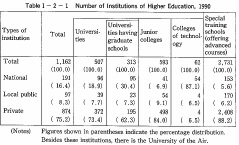
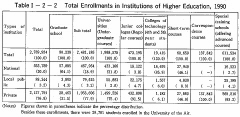
The ratio of men to women is 3 to 2 for all universities and
junior colleges. For university undergraduate courses, male students account
for 72% of all students and female students 28%, while for Junior colleges male
students account for only 8% and female students 92%. Junior colleges play a
major role in offering high education to women.
Regarding the percentage distribution of entrants to universities
and junior colleges by major fields of study, entrants to social science courses
account for the highest percentage (39.9%), followed by engineering courses (19.4%)
and humanities courses (15.59%). For national universities, entrants to courses
of engineering, education and social sciences account for a relatively high percentage
respectively, while for private institution entrants to courses of social science,
humanities and engineering account for a relatively high proportion. (See Chart
![]() -2-4.) As regards junior colleges, the proportion of entrants to the following
courses is relatively high: humanities (26.6%), home economics (25.2%) and education
(16.6%). (See Chart
-2-4.) As regards junior colleges, the proportion of entrants to the following
courses is relatively high: humanities (26.6%), home economics (25.2%) and education
(16.6%). (See Chart ![]() -2-13.)
-2-13.)
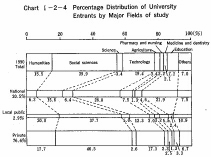
An international comparison of the percentage distribution of
students by major fields of study indicates that the pattern of the distribution
in Japan is quite similar to that in the United States. In Japan the proportion
of students enrolled in social science courses (including law and economics)
and education courses is higher than in the United Kingdom and some other countries,
and the proportion of students enrolled in science courses is lower.
An analysis of the regional distribution of institutions of higher education and the number of entrants indicates that these institutions are too much concentrated in large cities. It can be stated, However, that the regional imbalance in access to higher education has been gradually remedied due to government measures for restricting the establishment of new universities, or the expansion of existing universities in large cities, and also due to measures for helping set up and expand universities in small cities.
The proportion of the age group advancing to universities and
junior colleges in 1990 ranged from 45.3% in Tokyo to 22.6% in Aomori. The regional
imbalance in1990, however, was much smaller than in 1975. (See Table ![]() -2-3.)
The regional imbalance with regard to the" regional capacity of higher education" has
been decreasing, as well. (The "regional capacity" was calculated by dividing
the number of entrants to universities and junior colleges located in a particular
region by the number of upper secondary school graduates from the region who
were admitted to universities and junior colleges in Japan.)
-2-3.)
The regional imbalance with regard to the" regional capacity of higher education" has
been decreasing, as well. (The "regional capacity" was calculated by dividing
the number of entrants to universities and junior colleges located in a particular
region by the number of upper secondary school graduates from the region who
were admitted to universities and junior colleges in Japan.)
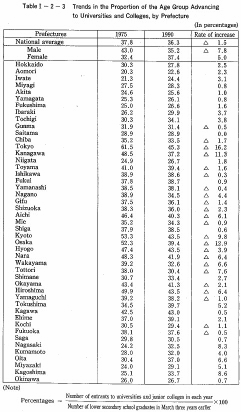
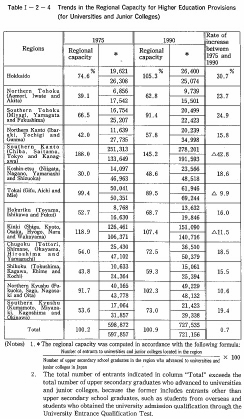
The total number of applicants to universities and junior colleges reached approximately 1,160,000 in 1990, and the total number of successful applicants was about 730,000. Both these figures represented the highest in the past.
The increase in the number of applicants to universities and junior colleges was due to a rapid increase in the population aged 18 and an increase in the proportion of upper secondary school students who apply to universities and junior colleges. In recent years, in particular, the proportion of upper secondary school students applying to universities and junior colleges have tended to increase. This trend has been a major factor affecting the increase in the number of applicants in recent years.
The proportion of the age group advancing to universities, junior colleges and colleges of technology (the fourth year) was 36.8% in 1990. During four years from 1987 to1990, the proportion had kept the level of more or less than 37%. The proportion of the age group entering universities and junior colleges was 36.3% in1990. (Of this total, 24.6% was for universities and 11.7% for Junior colleges.) In recent years, the perecrant age of female students going on to universities and junior colleges has been increasing substantially. In 1989 the proportion of the age group advancing to these institutions became higher for female than for male. (In 1990 it was 35.2% for male and 37.4% for female. The proportion of the age group advancing to universities was 33.4% for male and 15.2% for female. The percentage of the age group going on to junior colleges was 1.7% for male and 22.2% for female)
An international comparison indicates that the proportion of
the age group going on to higher education (excluding special training schools)
in Japan is at a very high level among selected advanced countries. Considering
that in such countries as the United States and West Germany [referred to the
Federal Republic of Germany before 3 October 1990 when East Germany (German Democratic
Republic) was unified with the Federal Republic entrants to institutions of higher
education include a substantial number of adult students, it can be stated that
the percentage of the 18-year-old age group entering higher education in Japan
is at a very high level.(See Chart ![]() -2-1.)
-2-1.)
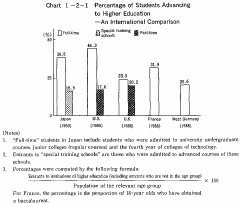
Further, if entrants to special training schools (advanced courses)
are added, the total number of entrants to institutions of post-secondary education
in Japan amounted in 1990 to approximately 1,080,000, representing 53.7% of the
age group. This fact means that one half of all 18-year olds in Japan have gained
access to higher education. (See Chart ![]() -2-2.)
-2-2.)
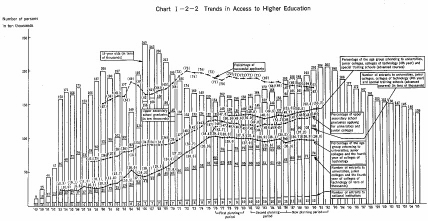
| Back to Top | MEXT HOME |